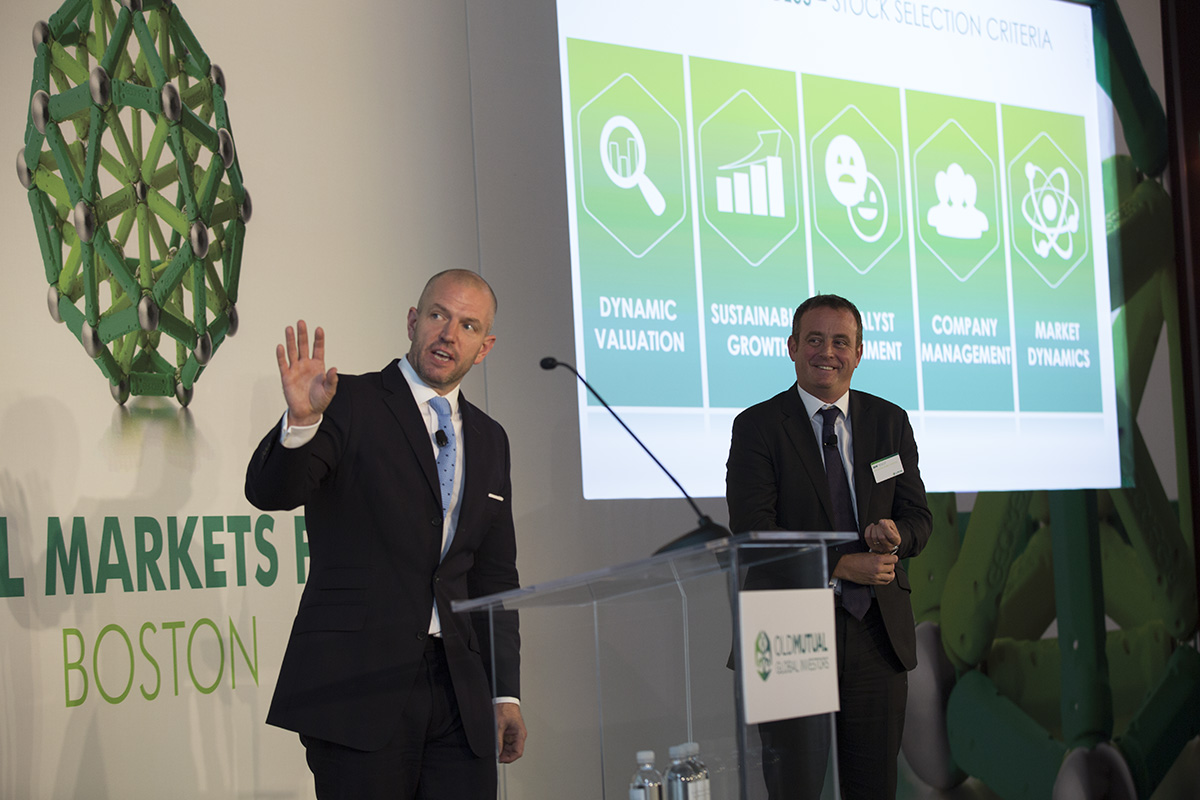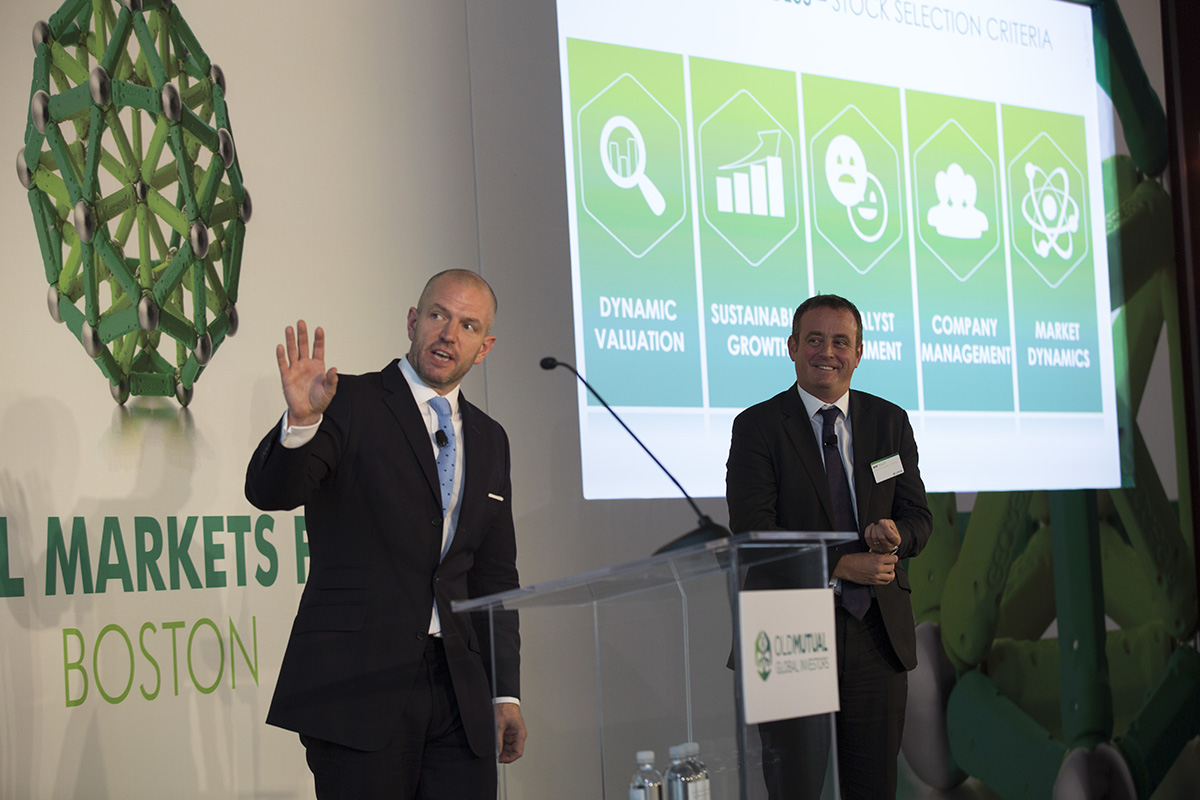In Miami, Martin Hofstadter, Offshore Business Director at Lord Abbett and Andrés Munho, Sales Manager for Latin America, Florida and Texas at Old Mutual Global Investors, welcomed US Offshore industry professionals to a lively panel on global macroeconomics. Moderated by Gustavo Cano, Director of Product and Strategy for UHNW LatAm clients at BBVA Compass, the event was attended by Tim Paulson, Fixed Income Strategist at Lord Abbett and Justin Wells, Global Equity Strategist at Old Mutual Global Investors.
Once the panel was over, the event was attended by Dr. Roberto Canessa, a renowned cardiologist and one of the sixteen survivors of the plane which crashed in the Andes in 1972.
The debate on the macroeconomic environment began by evaluating the performance of central banks, which continue to keep interest rates at low levels for a longer period of time. According to Justin Wells, it’s very complicated for the Fed to diverge radically with the rest of the main central banks, because this could cause strong volatility with respect to the rest of the currencies. In his view, central banks will maintain very benign levels of volatility despite an increase in geopolitical risks that is much greater in developed markets.
While Tim Paulson pointed to the great correlation between asset prices and balance sheet volumes of central banks. “We hope that as the Fed begins to unwind its balance sheet, the impact of its actions in the equity shares market will be reduced. We expect to see risk premiums begin to recover, at present, it’s clear that the European Central Bank’s and the Bank of Japan’s actions are surpassing the Fed’s normalization attempts, which are still very small reductions.”
Lord Abbett’s strategist argued that as long as the tremendous search for returns on revenue continues in the world, which results from the demographics of developed economies, we will continue to see low interest rates for some time. “If you compare returns on German sovereign debt with those of US debt, the latter are higher, but if you take into account the cost of currency hedging, both are more or less at the same level. US rates are at current levels due to the influence of the rate levels in Europe and Japan. And, all rates are moving together, affecting currencies. In this model, if the currency’s hedging goes up, the Fed’s rate goes along with this increase. There is massive global arbitration.”
According to Paulson, the market is expecting less aggressive behavior from the European Central Bank. “Just because they cut down from buying 60 billion to buying 30 billion, does not mean that at some point the market is going to decrease its purchase speed. In Europe, they are still trying to remain behind the Fed, but they continue to buy more than the market is able to digest. Everyone competes against everyone for profitability,” says Paulson.
As for the possibility of overheating the market, in which more and more investors are looking for the first indications that a correction may be taking place, Justin Wells said that there is strong speculation about a potential correction and about why is it’s different this time. “The relationships of conventional metrics with the correlation of the market are breaking down. There is a huge level of disruption in the economy, which is very interesting.”
Meanwhile, Tim Paulson, joked with the idea of ensuring a recession in the future. “While a possible recession may come in 6 months or in10 years, none of the market participants can say when. Economic data show that the chances of a recession in the next 6 or 12 months are lower than average. A recession is possible, but unlikely in the near future. The risk is that there is always going to be something that cannot be predicted, something that causes a recession. While it is unlikely that a recession will occur with a risk of restructuring and real loss of assets as a result of the behavior of central banks, it cannot be ruled out, as it can happen. At no time in history has it been so easy to access the capital markets. A rise in interest rates may put some pressure on the markets and bring them down, but we are far from a horrible decision being made by the Fed.”
Another issue that was mentioned during the debate was the US tax reform. According to Paulson, it’s not an issue that they are implicitly considering in their strategies and he does not believe that anyone in the market is doing it. “You cannot bet on the possible final result of the tax reform. All that can be done is watch which assets will be affected by the fiscal reforms, and if everyone is taking into account the same type of tax reform or that it will happen with the same probability. It is not a question that can be easily solved, but it is how you usually play this type of events; looking for differences in probabilities.”
The absence of volatility and complacency in the markets
On the absence of volatility in the markets, Paulson commented that after the global financial crisis many investors did not leave behind a psychology of pessimistic tendency and continued to bet on quality and defensive styles. “This defensive mentality is what has allowed very low or very benign levels of volatility. We continue to see frequent rotations that can be very destructive, by sector and style, we feel that perhaps they reflect in a more accurate way the real level of volatility, which measured in terms of conventional metrics is simply not reflecting what is actually happening.”
For Wells, another factor that is reducing volatility is the use of quantitative models, since the existence of a reversion to the average calibrates the behavior of real activity, both in the depth of the market and on the surface. “Spreads compression, high price-to-earnings ratios, all these indicators are changes that affect risk premiums, this is really what the actions of central banks has killed. The dynamics of the markets have changed, more than 1.2 trillion dollars have abandoned large cap equity strategies since 2007, and at the same time 1.4 trillion dollars have gone into passive investment and smart beta, a huge change in terms of the underlying dynamics of the market. You need to have a process that is dynamic and that responds to it, against the change in the rules.”
According to Paulson, in a period of low volatility with incredibly cheap access to capital, businesses and consumers start making bad decisions and do not feel the weight of these decisions until after a while. They become more complacent, and eventually the pressure in the system also becomes complacent. Historically, the longer it stays in these periods of low volatility, the more violent the rupture. “In a period in which stocks and bonds have very high valuations, investors are beginning to look for opportunities in alternative investment by increasing the risk of their portfolios. Something similar to what has happened in Europe in the last six or seven years. Bond yields have turned negative and investors continue to invest because they still need more profitability, it is not logical; it ‘s only working because all investors are taking the same position at the same time. Markets can remain irrational and solvent for a long time. It’s classical of the herd mentality that investors exhibit when they are not clear in which direction to invest.”.
Lack of inflation
According to Paulson, inflation will be affected by the structural trend in the long term. The labor market in the United States is very tight, being one of the reasons why inflation has picked up a bit, but somehow deflation is being imported from Europe and Japan, something that may be reversing many of the trends that are happening. “As long as inflation remains at low levels, I am confident that risk assets will perform well or at least central banks will maintain their accommodative policies. The issue that may introduce some disruption is that inflation starts to grow faster than central banks expect and they then have to change their reaction.”
For Justin Wells, this is one of the areas in which they are seeing a greater disconnect between the convection that has worked so far and has stopped working, the classic Phillips curve. “The massive disruption that the real economy is suffering at this moment, with its winners and losers, has caused huge deflation, we are not seeing wage growth as a result of the introduction of new disruptive technologies. Some workers will be replaced by automation or other forms of disruptive technologies, at an incredible rate of disruption; something which, from the point of view of the active manager, will create a large number of opportunities.”
To conclude, the asset managers commented that for the following 12 months they still expect to be closely watching the levels of support that the Fed provides to the market, the pressures that are being created in the system and how to navigate them.
Dr. Canessa’s participation
During his presentation, once the debate ended, Dr. Canessa reminded the audience that it is not necessary to wait for a plane crash to enjoy life: “Don’t look at the mountain, it can be very steep, just look at the next step that has to be taken, and if you feel disappointed look at what you have achieved up to that moment, you cannot wait until the helicopters arrive to save you, you have to continue walking.”



